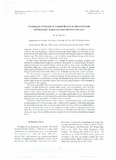| dc.description.abstract | Based on extensive field and literature surveys together with radiometric dating
evidence, the coastal geology of Kenya consists of the Karoo (Upper Carboniferous-Lower
Jurassic) to Recent sedimentary sequences with minor local intrusions of igneous rocks of post-
Jurassic age. The oldest sedimentary rocks found in coastal Kenya belong to the Karoo
sequence and are exposed in the Mombasa coastal basin.
In East Africa, the Karoo grabens were initiated by passive extensional regimes with
normal-fault displacements being the extensional mechanism. In coastal Kenya, the Karoo
graben was initiated in the Early Permian with the possible existence of pre-rift tillitic Dwyka
equivalent sediments of Late Carboniferous sediments. The extensional regime of coastal
Karoo basin terminated in the Jurassic when the basin was tectonically sealed off by the Late
Jurassic faults which heralded the drifting away of Madagascar from the African continent.
The Karoo basin is elongated in a broadly north-south direction and has a basin-fill of
approximately 6,500 - 7,000 m comprising alluvial, fluvial and lacustrine sequences. The
Karoo sediments in coastal Kenya constitute the Duruma Group which is equivalent to the
Karoo Super-group seen elsewhere in East Africa and they crop out onshore west of Mombasa
town parallel to the coastline.
The western boundary of the coastal Karoo basin is relatively more complex than the eastern
margin, with both faulted and unconformable contact with the basement, which is of the
Precambrian Mozambique Bell. The eastern margin of the basin is broadly defined by the post-
Karoo Middle Jurassic marine limestones of the Kambe Formation. The limestone has both
faulted and unconformable relationships with the underlying Duruma Group. The rest of the
post-Karoo sediments are mainly prograding marginal to deep marine and shoreline sequences
deposited in cycles separated by well-defined tectonic phases.
The uplift of the eastern shoulders of the Tertiary East African Rift during the Pliocene led
to down warping of the Kenya coastal region resulting in the deposition of fluviatile sediments
of the Marafa Formation. The coastal area emerged later in the Late Pliocene to Early Pleistocene,
at which time dune sands of the Mauarini Formation .and other lagoonal sands were
deposited. In the Quaternary period.coastal Kenya was the desposition of dune and lagoonal
sands, and the growth of coral Iimestone, intercalated with continentally derived fluvial channel
sands. | en |

